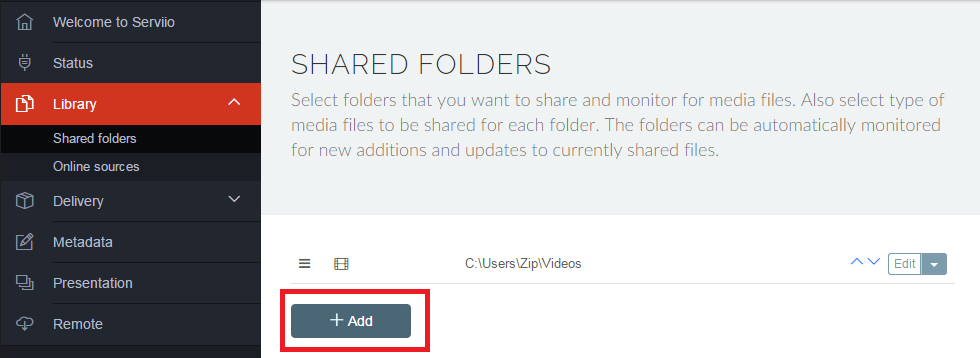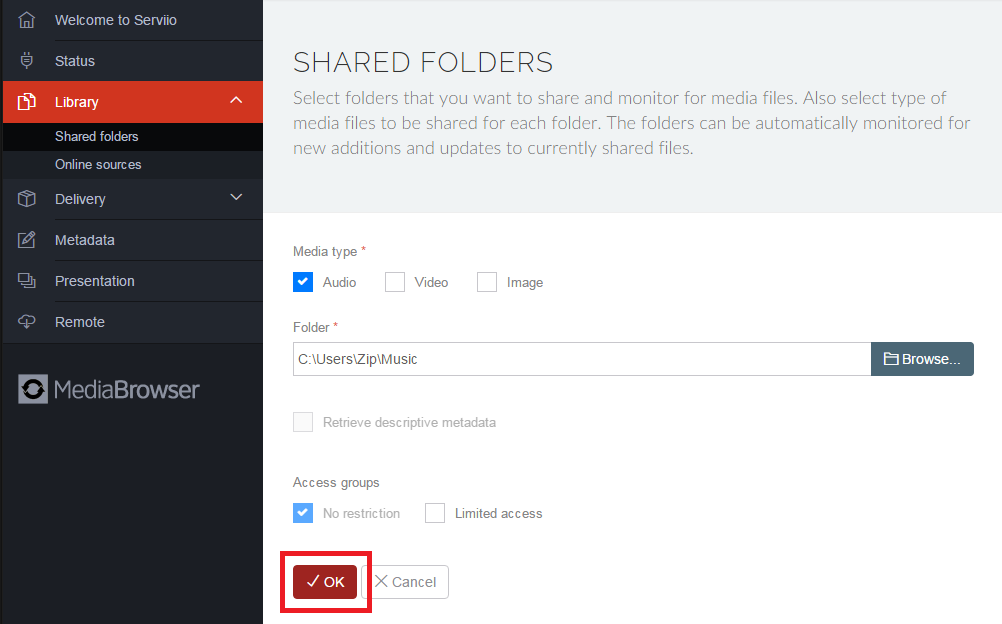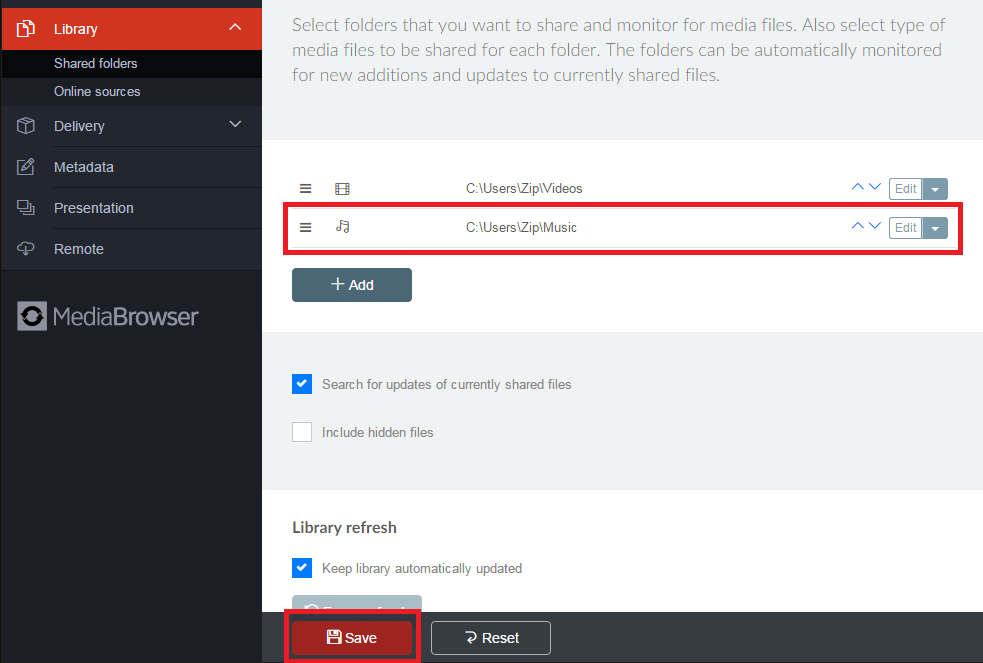News
About Us
Serviio is developed by Petr Nejedly, who currently lives in London and works as a freelance Scala consultant.
Serviio uses some open-source libraries without which it would not have been possible. We would like to thank all the people who contributed to them.
Acknowledgements
Products used in Serviio and their licenses
- This product includes portions of FFmpeg (a great video library) which is licensed under GPL v2.0
- This product includes LAME MP3 Encoder (a high quality MPEG Audio Layer III (MP3) encoder) which is licensed under LGPL v2.0.
- This product includes x264 which is licensed under GPL v2.0.
- This product includes software developed by The Apache Software Foundation which is licensed under ASL v2.0.
- This product includes software developed by the Visigoth Software Society.
- This product includes Jaudiotagger (an audio tagging library) which is licensed under LGPL
- This product includes SLF4J (a logging facade) which is licensed under MIT licence
- This product uses NSIS (an installer packager tool) which is licensed under zlib/libpng licence
- This product uses Restlet which is licensed under LGPL v2.1
- This product includes Rome (an RSS library) which is licensed under ASL v2.0.
- This product includes software developed by the JDOM Project.
- This product includes librtmp which is licensed under LGPL v2.1.
- This product includes Winp which is licenced under MIT licence
- This product includes dcraw
- This product includes jNAT-PMPlib which is licended under LGPL 3.0
- This product includes libASS which is licended under New BSD Licence
- The Software includes aXMLRPC which is licensed under MIT licence
- The Software includes imgscalr which is licensed under ASL v2.0.
Services used by Serviio
- This product uses the TMDb API but is not endorsed or certified by TMDb. Please consider contributing to the database.
- Online subtitles service powered by www.OpenSubtitles.org
Download
The latest release
The latest released version is 2.4 Pro. Download it here and give it a try. You will get a 15 day evaluation of the Pro edition, after which Serviio automatically reverts to the Free edition.
If you previously purchased a Pro license for version 1.x, it will no longer be valid after you upgrade to 2.x. You can still keep using the latest 1.x release in case you don't want to upgrade.
Release notes are here: Release Notes - 2.4.
 |
serviio-2.4-win-setup.exe | 134,099,272 bytes, MD5: 2c41341b4f0ae9b340d277df918cbc00 |
 |
serviio-2.4-osx.tar.gz | 127,293,858 bytes, MD5: 989a4e666ead3ec011206d262e4a3332 |
 |
serviio-2.4-linux.tar.gz | 28,887,039 bytes, MD5: 17f4feb74402d37b74c91c8b9532cc91 |
 |
Serviio 2.4 for QNAP Intel 32bit, Intel 64bit, ARM x19, ARM x31, ARM x41+, ARM 64bit | |
 |
Serviio 2.1 package for Synology NAS | |
Are you upgrading and wish to keep your media library? Check out how to do it.
By downloading this software you agree to the terms of the End User Licence Agreement. For commercial licence details look at the Contact page.
This release includes FFmpeg (post) 5.1.2 compiled using this source code, libRTMP 2.4+ compiled using this source code, Lame MP3 Encoder (v. 3.99.5) compiled using this source code. Refer to README.txt for the complete list.
Minimal requirements
- 512 MB of memory or more
- 150 MB of disk space (plus additional space for storing the media library), when using transcoding make sure there is at least 1GB free (depending on the original file size)
- if on Linux, Java 8 must be installed. Windows and OSX come with Java runtime aready included in the installation.
Additional information
- Linux users need to install the FFmpeg package (incl. libRTMP, libASS, libx264 and libmp3lame) for their OS distributions or, ideally, compile FFmpeg using the source files provided above
- Linux users need to install the dcraw package if they need RAW image support
- Only 64-bit OSX machines are supported, with OSX 10.8 minimum
Troubleshooting
If you have problems with the latest release, have a look at Getting started guide or let us know in the Support forum.
The legacy release
If you require the latest 1.x release, here are the details. Use this if you have Pro v1 license and don't want to upgrade to v2.
 |
serviio-1.10.1-win-setup.exe | 161,814,192 bytes, MD5: 1b40a0bab3228aa91cf1b4f8555c0715 |
 |
serviio-1.10.1-osx.tar.gz | 152,794,145 bytes, MD5: f7294626ac5380040a1abe8c70ba75e7 |
 |
serviio-1.10.1-linux.tar.gz | 28,413,154 bytes, MD5: 24b8b85c91aac76ea654d3dc54486b9e |
 |
Serviio 1.10.1 for QNAP Intel 32bit, Intel 64bit, ARM x19, ARM x31, ARM x41+ | |
 |
Serviio 1.10.1 package for Synology NAS | |
 |
Serviio 1.6.1 package for Asustor NAS is available in your NAS App Central | |
 |
Serviio 1.10.1 package for ClearOS | |
Getting started
Before installation
- Make sure your environment complies with minimal requirements.
- Linux users must install FFmpeg via their OS distribution package manager or build it from the sources on the Download page. The Wiki has some useful guides.
Installation
- Windows users can simply run the downloaded installer and go through the wizard. The Serviio server will be installed as a Windows service.
- Linux users need to unpack the installation package to a desired location.
- Mac users need to unpack the archive and run the installer.
Running the server
Serviio consists of 2 executable files, a server and a console. To start using Serviio do the following:
- Windows - the server starts automatically after Windows start (as a service). Run ServiioConsole to start the console. Alternatively you don't have to start Serviio as a service but use bin/serviio.bat (with the -stop attribute to stop a running instance).
- Linux - run Serviio server with bin/serviio.sh (with the -stop attribute to stop a running instance). To start the console run bin/serviio-console.sh. A Daemon setup guide is available.
- OSX - the server starts automatically after OSX start (as a LaunchDaemon). Run ServiioConsole application to start the console.
You can also access the Console in your favourite web browser, by going to this address:
http://localhost:23423/console
Only one instance of the server can run at a given time on a single machine.
In a case when the machine running Serviio has multiple network cards (NICs) it will try to work out which one is the right one to advertise on. If Serviio doesn't seem to communicate with your device make sure you select the right network card in the field "Bound IP address" in the console. More details here.
Adding content to Serviio's media library
- Open the Serviio console
- Select the Library and then Shared folders section in the menu

- Add folders that include media files you want to include in the library and pick what type(s) of media files from those folders should be looked for (Video, Audio, Images). You can specify if descriptive metadata (e.g. online metadata, XBMC, Swisscenter, MyMovies) should be retrieved for video files in particular folders, which might be useful to control, for example, metadata of your home videos.

- Click Save to store your new shared folders configuration

- You can fine tune access to the shared content for various users
- You can also add online resources to the library
- Click the Save button when you are done.
- The library will now be updated and then kept up-to-date when Serviio detects new or updated files.
- Note that when you add a large amount of files (e.g. during your initial setting up) it might take cosiderable amount of time (even several hours) to properly locate metadata for all your files (especially if you are using online sources for metadata searching).
- You can force checking for new or updated files by clicking "Force refresh" button.
- get more information on the wiki
Renderer profiles
DLNA devices sometimes need a little 'tweaking' for them to play all possible supported media formats and for their extra features to be utilized. Renderer profiles take care of this.
Serviio comes with a predefined set of profiles. If your device is not supported yet we encourage the users to try writing their own profile and submitting it back to us so that we can include it in a future release of Serviio. Look here for a short guide on how to add a new profile.
You can select the appropriate profile in the Status section. You will see a list of devices that were found on your network. If your device has been recognized and a proper profile has been determined you can start viewing your content. In other cases you might have to select a profile for the found device, by clicking the Edit button.
All unrecognized devices will default to Generic DLNA profile.
Having trouble?
If you are experiencing difficulties with your setup, please check the Support Forums and Users Knowledge base. You can also have a look at Sony UK instruction video or read TechRadar's or APC mag's guides.
Features
- streams audio, video (SD & HD) and image files in their native format or transcoded in real-time
- streams content from online sources, like RSS feeds, live audio/video streams, web page content
- includes a plugin system to support streaming from non-trivial online sources
- supports most known playlist formats
- supports subtitles
- automatically updates the media library when you add/update/remove a media file or a metadata file
- supports RAW camera images
- wide array of localized library browsing options
- supports different editable renderer profiles
- supports automatic renderer detection and per-IP profile assignment
- extracts metadata of your media files the way you want it, incl. embedded metadata tags, local metadata files, online metadata sources (in preferred language), XBMC, Swisscenter, MyMovies
- supports video thumbnails, CD covers, DVD posters, etc.
- categorizes video files into movie and/or series and marks last viewed episodes of a series
- integrates with trakt.tv
- Alexa skill available
- available for Windows, Linux, Mac and several NAS platforms
Supported renderers
|
|
Supported media files
- Audio: MP3( .mp3), MP2 (.mp2), Windows Media Audio (.wma), WMA Lossless (.wma), AAC (.m4a, .m4b), OGG (.ogg, .oga), FLAC (.flac), Apple Lossless ALAC (.mp4), Wawpack (.wv), Musepack (.mpc), Monkey's Audio (.ape), DSF (.dsf), WAV (.wav),
- Video: MPEG-1 (.mpg, .mpeg), MPEG-2 PS (.mpg, .mpeg, vob, mod), MPEG-2 TS (.ts, .m2ts), MPEG-4 (.mp4, m4v, mov), AVI (.avi, .divx), Windows Media Video (.wmv, .asf), Matroska (.mkv), Flash (.flv, .f4v), DVR-MS (.dvr, .dvr-ms), WTV (.wtv), OGG (.ogv, .ogm), 3GP (.3gp, .3g2), RealVideo (.rm, .rmvb), WebM (.webm)
- Image: JPEG (.jpg, .jpeg), GIF (.gif), PNG (.png), RAW (.arw, .cr2, .crw, .dng, .raf, .raw,. rw2, .mrw, .nef, .nrw, .pef, .srf, .orf)
- Playlist: PLS (.pls), M3U (.m3u, .m3u8), ASX (.asx, .wax., .wrx), WPL (.wpl)
- Subtitles: SubRip (.srt, .txt), SSA/ASS (.ssa, .ass), MicroDVD (.sub, .txt), SAMI (.smi), VTT (.vtt), MOV open text
On the Go
Access your files anywhere with Pro edition. Use MediaBrowser or one of the Apps to enjoy your content over the Internet.
Control with your voice
You can control Serviio just with your voice and Alexa device. Simply say what you want to watch and let the magic begin.
